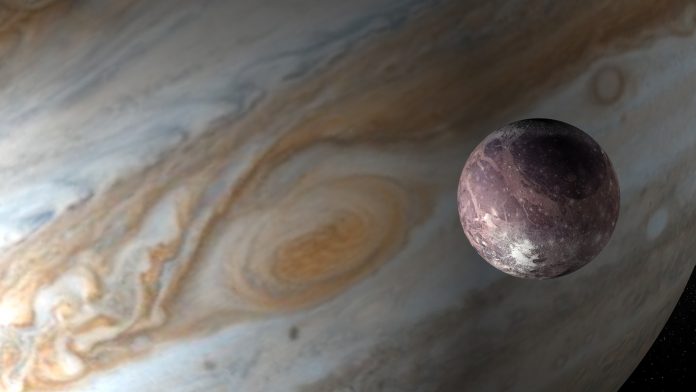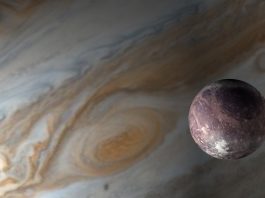A team of scientists has identified that the atmosphere of Jupiter’s moon Ganymede is comprised of a considerable amount of water vapour.
The discovery, obtained by researchers from the KTH Royal Institute of Technology in Stockholm, has signified that Jupiter’s moon Ganymede – which has an icy composition and is the largest moon in the solar system – has an atmosphere that is rich in water vapour.
To conduct their study, the researchers, who were led by Dr Lorenz Roth, utilised spectral images of Ganymede that were attained with the Hubble Space Telescope, allowing them to comprehensively analyse the atmosphere of Jupiter’s moon. Additionally, the work of scientists from the Southwest Research Institute (SwRI) was instrumental in the discovery, with the team examining datasets from the Hubble Space Telescope and comparing them to the expected values of atmospheric emissions.
New insights of Jupiter’s moon
The atmosphere of Ganymede is created by the charge particle erosion and sublimation of its icy surface – sublimation takes place when the ice turns directly into a gas without turning into a liquid. In prior investigations of Jupiter’s moon, scientists had employed far-ultraviolet observations to locate both atomic oxygen (O) and molecular oxygen (O2) in Ganymede’s atmosphere; however, they did not detect the water that they had expected to find. This novel study found that H2O is considerably more abundant than oxygen at the subsolar point of the moon, which is when the Sun is at its zenith – directly above the moon – the point in which its rays are most intense.
Dr Kurt Retherford, from the Southwest Research Institute and co-author of the Nature Astronomy paper describing this research, said: “Sublimated water vapour at high noon on Ganymede, where the surface is relatively warm, is likely a key feature of the tenuous atmospheres of Jupiter’s icy moons.
“As we prepare to launch NASA’s Ultraviolet Spectrograph (UVS) instrument, built and led by SwRI, aboard the European Space Agency’s (ESA’s) Jupiter Icy Moons Explorer (JUICE) mission next year, this new understanding of Ganymede’s atmosphere will let us better plan our observations and enhance our science return.”
Understanding the atmosphere
The team of scientists hypothesised that molecular oxygen is the most abundant element in Ganymede’s atmosphere due to it being stable, gravitationally bound, and less likely to cause a reaction with materials on the surface. Contrastingly, atomic hydrogen (H) and hydrogen gas (H2), which are lighter products of the ice surface erosion, are far less abundant and therefore escape faster.
On the surface of Ganymede, the temperatures range between 80 Kelvin (-315 F) to potentially as high as 150 K (-190 F). However, water molecules only fly off and sublimate when temperatures exceed 110 K (-260 F), which makes them bind to cold and frozen surfaces, therefore making the abundance of water elsewhere in the atmosphere more limited.
Following on from this, the team conducted atmospheric modelling, which identified a distinct contrast in Ganymede’s atmosphere, as warmer regions where the Sun is overhead were dominated by H2O and the atmosphere was dominated by O2 everywhere else.
Dr Randy Gladstone, a co-author of the study from SwRI, said: “Showing that water vapour is a large fraction of the atmosphere of Ganymede — at least where the Sun is high — is a very timely result. NASA’s Juno spacecraft is currently making close-up observations of Ganymede, including the emissions observed by HST, and these new results will be used to plan future observations with JUICE, which is designed to orbit Ganymede in 2033.”
Dr Philippa Molyneux, who is also a co-author of the research from SwRI, commented: “It’s interesting to think of an atmosphere that has a very different composition on its dayside relative to its nightside, with completely different processes driving the production of gases at different locations. Imagine if Earth’s atmosphere worked that way, and how life might have evolved to adapt to that changing environment.”








